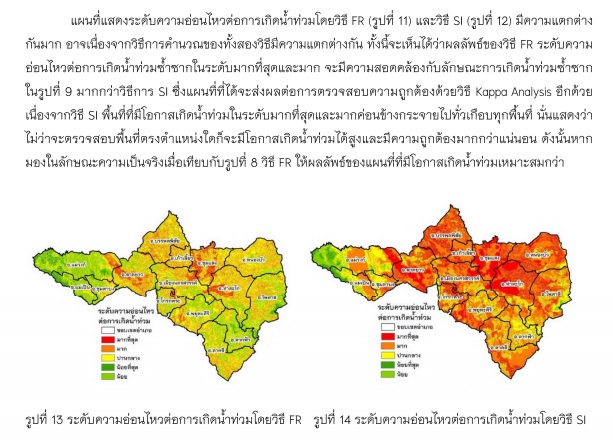การสร้างแผนที่ความอ่อนไหวในการเกิดน้ำท่วมโดยใช้วิธีอัตราส่วนความถี่และดัชนีทางสถิติ กรณีศึกษาจังหวัดนครสวรรค์
คำสำคัญ:
น้ำท่วม, วิธีอัตราส่วนความถี่, วิธีดัชนีทางสถิติบทคัดย่อ
งานวิจัยนี้มีวัตถุประสงค์เพื่อ 1) วิเคราะห์และจัดทำแผนที่แสดงพื้นที่ที่มีความเสี่ยงต่อการเกิดน้ำท่วมในพื้นที่ จังหวัดนครสวรรค์ โดยการประยุกต์ใช้ระบบสารสนเทศภูมิศาสตร์ร่วมกับการวิเคราะห์ด้วยวิธีอัตราส่วนความถี่ (FR) และวิธีดัชนีทางสถิติ (SI) และ 2) เปรียบเทียบความถูกต้องของแผนที่ความอ่อนไหวต่อการเกิดน้ำท่วม ในการศึกษาครั้งนี้ทำการวิเคราะห์ปัจจัยเชิงพื้นที่ที่มีอิทธิพลต่อการเกิดน้ำท่วม จำนวน 7 ปัจจัย ประกอบด้วย ความลาดชัน การใช้ประโยชน์ที่ดินและสิ่งปกคลุมดิน การระบายน้ำของผิวดิน ความสูงภูมิประเทศ ความหนาแน่นเส้นทางถนน ความหนาแน่นเส้นทางน้ำ และปริมาณน้ำฝนรายปี นำปัจจัยดังกล่าวมาวิเคราะห์ร่วมกับพื้นที่น้ำท่วมที่เคยเกิดขึ้นระหว่าง ปี พ.ศ. 2550 - 2559 โดยแบ่งลักษณะการเกิดน้ำท่วมเป็น 2 รูปแบบ คือ พื้นที่น้ำท่วมซ้ำซาก และพื้นที่เคยเกิดน้ำท่วมกับไม่เคยเกิดน้ำท่วม เพื่อทำแผนที่ความอ่อนไหวต่อการเกิดน้ำท่วมในจังหวัดนครสรรค์ ผลจากการศึกษาพบว่า พื้นที่ที่มีความอ่อนไหวมากที่สุด มาก ปานกลาง น้อย และน้อยที่สุด กรณีการเกิดน้ำท่วมซ้ำซาก วิธีอัตราส่วนความถี่ ครอบคลุมพื้นที่ 669.12 ตร.กม. 190.74 ตร.กม. 283.48 ตร.กม. 5,719.75 ตร.กม. และ 2,651.34 ตร.กม. ตามลำดับ ส่วนวิธีดัชนีทางสถิติ ครอบคลุมพื้นที่ 1,566.91 ตร.กม. 3,651.75 ตร.กม. 3,145.81 ตร.กม. 1,044.17 ตร.กม. และ 105.78 ตร.กม. ตามลำดับ ส่วนกรณีพื้นที่เคยเกิดน้ำท่วมและไม่เคยเกิดน้ำท่วม วิธีอัตราส่วนความถี่ ครอบคลุมพื้นที่ 242.58 ตร.กม. 2,400.17 ตร.กม. 4,385.40 ตร.กม. 2,189.33 ตร.กม. และ 296.94 ตร.กม. ตามลำดับ ส่วนวิธีดัชนีทางสถิติครอบคลุมพื้นที่ 2,034.85 ตร.กม. 5,107.32 ตร.กม. 1,884.46 ตร.กม. 371.80 ตร.กม. และ 115.99 ตร.กม. ตามลำดับ แผนที่ความอ่อนไหวต่อการเกิดน้ำท่วมจังหวัดนครสวรรค์ กรณีพื้นที่น้ำท่วมซ้ำซาก วิธีอัตราส่วนความถี่ มีความถูกต้องเท่ากับ 80.13% วิธีดัชนีทางสถิติ มีความถูกต้องเท่ากับ 89.06% กรณีพื้นที่เคยเกิดน้ำท่วมและไม่เคยเกิดน้ำท่วม วิธีอัตราส่วนความถี่ มีความถูกต้องเท่ากับ 78.34% วิธีดัชนีทางสถิติ มีความถูกต้องเท่ากับ 88.12% ดังนั้น วิธีดัชนีทางสถิติมีประสิทธิภาพในการวิเคราะห์หาพื้นที่ที่มีความเสี่ยงต่อการเกิดน้ำท่วมดีกว่าวิธีอัตราส่วนความถี่





